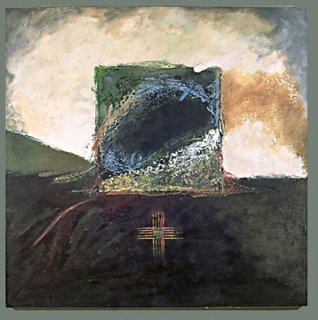Good Mistakes
"He was gifted with the special capability of making many mistakes, mostly in the right direction. I envied him for this and tried in vain to emulate him, but found it quite difficult to make good mistakes."- Goro Shimura, speaking of Yutaka Taniyama
I read the above some years ago, in a book about the proving of Fermat's Theorem. At the time, it seemed mostly to be a statement about how some people advance their thinking in intuitive leaps, and then go back and fill in the gaps with linear reasoning. It wasn't until later that I started thinking of 'good mistakes' in the context of art. Just this past week, I saw a very interesting show of the work of John Greene, who does all sort of neat stuff but works mostly in encaustic - pigmented wax on a solid surface. At the artist's reception, he gave a glowing account of this process, heating the wax, adding pigment, and applying the hot wax to the painting. At one point he fell silent for a moment, then continued with "It's a process which features lots of mistakes - good mistakes". For me, it was one of those moments where the neon arrows appear, pointing to the speaker, and the letters underneath the arrows read 'Pay Attention!!"
Just this past week, I saw a very interesting show of the work of John Greene, who does all sort of neat stuff but works mostly in encaustic - pigmented wax on a solid surface. At the artist's reception, he gave a glowing account of this process, heating the wax, adding pigment, and applying the hot wax to the painting. At one point he fell silent for a moment, then continued with "It's a process which features lots of mistakes - good mistakes". For me, it was one of those moments where the neon arrows appear, pointing to the speaker, and the letters underneath the arrows read 'Pay Attention!!"
One of the things I miss when working on a photograph digitally is the serendipitous mistakes that were part of the wet darkroom process. On my enlarger, forgetting to flip the 'white light' lever back to 'filtered' was a big source of mistakes for me - I've made a lot of prints darker and harder than I intended as a result.
Often those dark, hard prints can show some pretty interesting stuff. I learned a lot about the space of possible prints by making humbling mistakes in the darkroom and taking the time to look at the results instead of just throwing them out. My fondness for making full size test strips (prints with exposure varying in steps across the print) is based largely on the fact that a test strip is a series of carefully spaced mistakes that let us look at a bunch of mistakes all at once and then extract useful information from them.
It makes me think I'd do well to make similar 'intentional mistakes' (which might also be called 'exploration') when I work on prints digitally.

0 Comments:
Post a Comment
<< Home